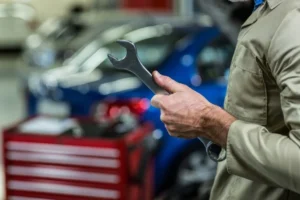Unmaintained vehicles can lead to water ingress, which means they’re no longer watertight. You may not know your vehicle is letting in water until you experience particularly bad weather and water damage has played havoc with your car’s interior.
The main areas that allow water to seep through into your car are the seals around doors, windows and sunroofs.
What is water ingress in cars?
What causes water ingress in cars?
If you have found water in your car, it’s likely to have been caused by:
- Weak/broken seams or gaskets on a vehicle’s roof
- Blocked sunroof drain holes on a vehicle’s roof
- Loose/broken windscreen gaskets on a vehicle
- Clogged AC evaporator drain
- Heater core leak
What are the problems and symptoms of water ingress in cars?
Weak/broken seams or gaskets on a vehicle’s roof
Broken seams around a sunroof that go unnoticed can rust and allow water inside your car. Look for cracked or bubbling paintwork along the seams in the roof to find out if this is the culprit. If you do notice this, park your car under shelter, where possible, until you can get the problem professionally solved.
Metal roof panels on a car are typically connected with rubber gaskets, these can wear over the years, which means any water that finds itself in the cracks can become trapped, freeze and expand. When this happens, you’re likely to find water in the middle of your vehicle’s interior.
Blocked sunroof drain holes on a vehicle’s roof
If you’ve checked for broken gaskets, bubbling paint and rust, and still haven’t found the reason for your vehicle’s water ingress, then check the roof’s drainage. If your sunroof’s drain is blocked, this might be your problem.
Like all drains, when there’s something stopping the water flow, water can begin to flood. Have a professional clear out your sunroof drain and this will resolve your water ingress issue.
Loose/broken windscreen gaskets on a vehicle
Windscreen gaskets see it all; fluctuating temperatures, vibrations when in motion and general wear and tear. They can all cause the seals around a windscreen to degrade more quickly than other seals around the car. Check your seals for any cracks, breakages or gaps, and have the gasket replaced if you spot these signs.
Clogged AC evaporator drain
If you find water inside the footwell, you’ll want to check out your AC drain to see if it is full of debris, as this could be causing condensed water to spill out and into your car’s interior.
Heater core leak
A puddle resembling water in your footwells could actually be leaking coolant. This can cause your windscreen to fog when you’re driving, and the liquid is likely to smell – but if it’s odourless, it’s likely to be a leak from somewhere else. There are a few reasons as to why your heater core is leaking, so have it checked over by professionals to ensure the proper remedy.
Can all vehicles experience water ingress?
Yes but some are more prone to water ingress than others. Water ingress, if not caused by wear and tear from road dirt or grease can be down to ill-fitting seals around doors, windows and sunroofs.
The vehicles that typically experience water ingress include:
How is water ingress in cars fixed?
This completely depends on the vehicle’s diagnosis but chances are your car’s seals need replacing or you need to drain/fix your AC/heater core. Turn to your local professionals who will be able to offer peace of mind and ensure your car is free from water, weatherproof and safe to drive.
Text taken from: https://www.thewindscreenco.co.uk





